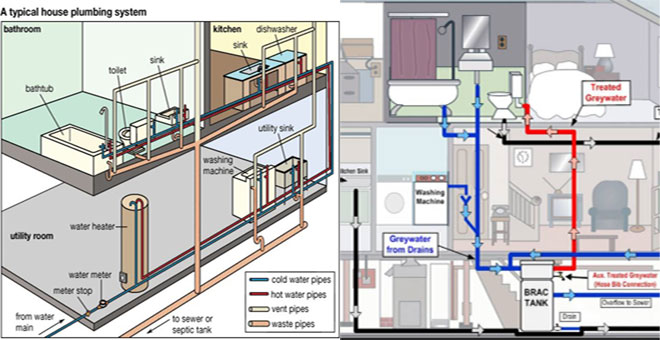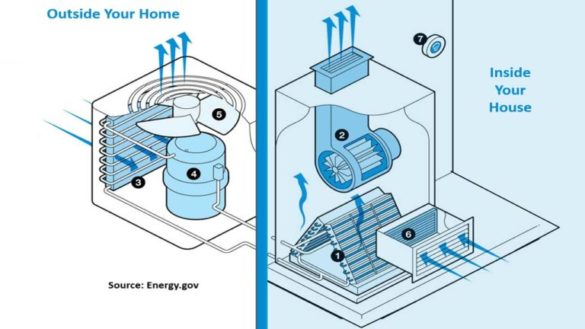An Overview to Your House's Plumbing System Anatomy
An Overview to Your House's Plumbing System Anatomy
Blog Article
They are making a number of great pointers regarding Exploring Your Homes Plumbing Anatomy as a whole in the content underneath.

Understanding exactly how your home's plumbing system works is important for each homeowner. From delivering clean water for alcohol consumption, food preparation, and showering to safely getting rid of wastewater, a properly maintained pipes system is vital for your household's health and wellness and comfort. In this extensive overview, we'll discover the detailed network that composes your home's pipes and offer suggestions on upkeep, upgrades, and dealing with common concerns.
Intro
Your home's plumbing system is more than just a network of pipelines; it's an intricate system that guarantees you have access to clean water and reliable wastewater removal. Understanding its parts and exactly how they interact can aid you avoid expensive repair services and ensure every little thing runs efficiently.
Basic Elements of a Pipes System
Pipes and Tubing
At the heart of your plumbing system are the pipelines and tubes that carry water throughout your home. These can be made of various materials such as copper, PVC, or PEX, each with its benefits in regards to toughness and cost-effectiveness.
Components: Sinks, Toilets, Showers, and so on.
Components like sinks, toilets, showers, and bath tubs are where water is utilized in your home. Recognizing how these components connect to the pipes system aids in identifying troubles and preparing upgrades.
Shutoffs and Shut-off Factors
Valves manage the circulation of water in your plumbing system. Shut-off valves are important during emergency situations or when you require to make repairs, allowing you to isolate parts of the system without interrupting water circulation to the whole home.
Water Supply System
Key Water Line
The major water line connects your home to the metropolitan water or a private well. It's where water enters your home and is dispersed to different components.
Water Meter and Stress Regulator
The water meter steps your water use, while a pressure regulatory authority makes certain that water flows at a secure pressure throughout your home's plumbing system, avoiding damage to pipes and fixtures.
Cold Water vs. Warm water Lines
Recognizing the difference in between cold water lines, which provide water directly from the main, and hot water lines, which carry heated water from the hot water heater, assists in fixing and preparing for upgrades.
Water drainage System
Drain Piping and Traps
Drain pipelines carry wastewater away from sinks, showers, and commodes to the sewage system or septic system. Traps avoid sewage system gases from entering your home and also catch particles that could trigger obstructions.
Ventilation Pipes
Ventilation pipelines enable air right into the drainage system, stopping suction that could slow drain and create catches to empty. Appropriate air flow is necessary for keeping the integrity of your plumbing system.
Significance of Correct Drain
Making certain correct water drainage stops back-ups and water damage. Consistently cleaning drains pipes and maintaining catches can stop expensive fixings and expand the life of your pipes system.
Water Heating System
Types of Hot Water Heater
Hot water heater can be tankless or traditional tank-style. Tankless heating systems heat water on demand, while tanks keep heated water for instant use.
Just How Water Heaters Connect to the Pipes System
Comprehending exactly how water heaters link to both the cold water supply and hot water circulation lines assists in diagnosing issues like insufficient hot water or leaks.
Maintenance Tips for Water Heaters
Regularly purging your water heater to remove sediment, checking the temperature settings, and inspecting for leaks can expand its life expectancy and enhance energy efficiency.
Common Plumbing Issues
Leakages and Their Reasons
Leaks can happen because of maturing pipelines, loose fittings, or high water stress. Resolving leakages quickly avoids water damage and mold and mildew development.
Blockages and Blockages
Clogs in drains and commodes are commonly triggered by purging non-flushable things or a buildup of grease and hair. Making use of drain screens and bearing in mind what drops your drains pipes can avoid clogs.
Indicators of Pipes Issues to Expect
Low water pressure, slow drains pipes, foul odors, or unusually high water bills are indicators of potential pipes problems that ought to be resolved promptly.
Plumbing Upkeep Tips
Routine Examinations and Checks
Arrange yearly plumbing assessments to capture problems early. Seek indications of leaks, deterioration, or mineral buildup in taps and showerheads.
DIY Upkeep Tasks
Simple tasks like cleansing faucet aerators, looking for commode leaks making use of color tablets, or shielding revealed pipes in cold climates can protect against major plumbing concerns.
When to Call a Professional Plumbing Professional
Know when a plumbing concern requires specialist expertise. Attempting complex repair services without appropriate understanding can bring about even more damage and greater fixing prices.
Upgrading Your Plumbing System
Reasons for Updating
Upgrading to water-efficient fixtures or replacing old pipelines can enhance water top quality, decrease water costs, and raise the value of your home.
Modern Plumbing Technologies and Their Advantages
Discover modern technologies like clever leakage detectors, water-saving commodes, and energy-efficient hot water heater that can conserve cash and reduce environmental effect.
Expense Factors To Consider and ROI
Compute the ahead of time costs versus long-term cost savings when thinking about pipes upgrades. Several upgrades spend for themselves with decreased utility bills and less repair services.
Environmental Effect and Conservation
Water-Saving Fixtures and Appliances
Mounting low-flow taps, showerheads, and bathrooms can dramatically lower water use without sacrificing performance.
Tips for Decreasing Water Usage
Straightforward routines like dealing with leaks promptly, taking much shorter showers, and running complete loads of washing and recipes can preserve water and reduced your energy expenses.
Eco-Friendly Pipes Options
Think about sustainable plumbing products like bamboo for floor covering, which is durable and eco-friendly, or recycled glass for countertops.
Emergency Readiness
Actions to Take During a Pipes Emergency situation
Know where your shut-off shutoffs are located and how to switch off the water in case of a burst pipe or major leakage.
Relevance of Having Emergency Situation Contacts Convenient
Keep contact information for regional plumbings or emergency situation services readily offered for fast response throughout a pipes situation.
DIY Emergency Situation Fixes (When Appropriate).
Temporary repairs like using air duct tape to patch a dripping pipeline or placing a bucket under a dripping faucet can lessen damage until a specialist plumbing gets here.
Final thought.
Understanding the anatomy of your home's pipes system equips you to maintain it effectively, saving time and money on fixings. By complying with normal maintenance regimens and remaining educated regarding modern pipes technologies, you can guarantee your plumbing system operates effectively for several years to come.
Understanding Your Home Plumbing System: A Comprehensive Guide
Plumbing System: The Lifeline of Your Home
At its core, the plumbing system is designed to perform two primary functions: bring fresh water into your home and remove wastewater. The system is a network of pipes, fixtures, and other components that transport water and sewage. Residential plumbing systems include potable water supply lines, drain-waste-vent (DWV) systems, and various plumbing fixtures that make water use in daily tasks possible.
Key Components:
Water Supply: This part of your plumbing system brings municipal water into your home, passing through the main water supply line. It s responsible for supplying all water needs, from drinking to bathing.
Drainage System: It carries waste and water away from your home to the sewer or septic system. This system includes all the piping within your home that leads to external sewage or septic systems.
Vent System: An essential yet often overlooked component, the vent system allows sewer gases to escape and lets air into the drainpipes, ensuring water and waste move correctly through the system.
Fixture: More Than Just Taps and Toilets
Plumbing fixtures are the most interactive parts of the plumbing system, including faucets, showers, toilets, and sinks. Each fixture is connected to the plumbing system and plays a role in either the delivery of freshwater or the disposal of waste and wastewater.
Types of Fixtures:
Faucets and Sinks: Used for washing hands, dishes, and other daily water needs.
Toilets: Dispose of human waste through the sewage system.
Bathtubs and Showers: Provide bathing facilities, requiring both hot and cold water supply.
Water Supply: The Source of Life
The water supply system is a critical component, ensuring that potable water is available throughout your home for various uses, including drinking, cooking, and cleaning. This system consists of pipes that distribute water to different parts of the house, controlled by valves to regulate the water flow.
Types of Plumbing: Materials and Methods
Various types of plumbing systems and materials are used in residential settings, each with its advantages and applications. From copper and PVC pipes for water supply to cast iron and ABS for drainage, the choice of materials can impact the longevity and efficiency of your plumbing system.
https://intownplumbingtx.com/articles/home-plumbing-system-guide/

Understanding Your Home Plumbing System: A Comprehensive Guide
Plumbing System: The Lifeline of Your Home
At its core, the plumbing system is designed to perform two primary functions: bring fresh water into your home and remove wastewater. The system is a network of pipes, fixtures, and other components that transport water and sewage. Residential plumbing systems include potable water supply lines, drain-waste-vent (DWV) systems, and various plumbing fixtures that make water use in daily tasks possible.
Key Components:
Water Supply: This part of your plumbing system brings municipal water into your home, passing through the main water supply line. It s responsible for supplying all water needs, from drinking to bathing.
Drainage System: It carries waste and water away from your home to the sewer or septic system. This system includes all the piping within your home that leads to external sewage or septic systems.
Vent System: An essential yet often overlooked component, the vent system allows sewer gases to escape and lets air into the drainpipes, ensuring water and waste move correctly through the system.
Fixture: More Than Just Taps and Toilets
Plumbing fixtures are the most interactive parts of the plumbing system, including faucets, showers, toilets, and sinks. Each fixture is connected to the plumbing system and plays a role in either the delivery of freshwater or the disposal of waste and wastewater.
Types of Fixtures:
Water Supply: The Source of Life
The water supply system is a critical component, ensuring that potable water is available throughout your home for various uses, including drinking, cooking, and cleaning. This system consists of pipes that distribute water to different parts of the house, controlled by valves to regulate the water flow.
Types of Plumbing: Materials and Methods
Various types of plumbing systems and materials are used in residential settings, each with its advantages and applications. From copper and PVC pipes for water supply to cast iron and ABS for drainage, the choice of materials can impact the longevity and efficiency of your plumbing system.
https://intownplumbingtx.com/articles/home-plumbing-system-guide/
I hope you enjoyed our section on The Inner Workings of Your Home's Plumbing. Thanks a lot for taking time to browse our article. If you enjoyed reading our blog posting kindly be sure to pass it around. Thank you for your time spent reading it.
Click Here To Read More Report this page